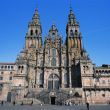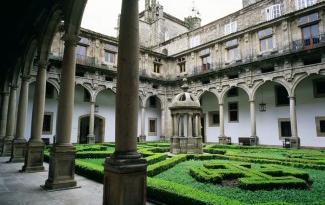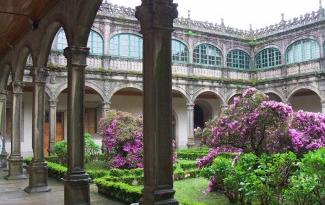Popular Classics
Old town–Santiago Cathedral–Plaza del Obradoiro–Hostal dos Reis Católicos–Colegio de Fonseca and Plaza de Fonseca–Plaza de Praterías–Plaza de A Quintana–Plaza de Azabachería-Cathedral rooftops
Special
Old Town
The best way of discovering the essence of Santiago de Compostela is strolling around the stone-paved streets and squares of its old town. Not to be overlooked in this stroll is the area of Bonaval Park, where the ethnographic museum called Museo do Pobo Galego and the Galician Centre of Contemporary Art are located. Another must-see is the park called La Alameda, which houses the emblematic polychrome statue called “Las Marías” and features unique views of the cathedral. The Church of San Martín Pinario and the Mercado de Abastos (food market) are other Compostela landmarks that are not to be missed.
Marvellous
Catedral and Squares
You have to visit the cathedral due to its striking interior, full of interesting details, and spectacular stone exterior. The squares surrounding this emblem of the city of Santiago de Compostela –Plaza del Obradoiro, Plaza de Platerías, Plaza de la Quintana and Plaza de la Inmaculada– enable you to enjoy different views of the cathedral.
Not to be missed
Santiago Cathedral
Discover the majesty of the cathedral –the most important work of Romanesque art in Spain– by visiting the main altar; the chapels in the main nave, ambulatory and transept; the “Portico of Glory” created by Master Mateo; the Cathedral Museum, the Cloister or the Crypt; as well as the rooftops, from which you can enjoy panoramic views of the city.
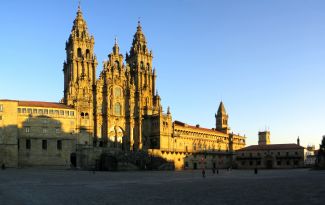
Inevitable
Plaza del Obradoiro
This square, which welcomes pilgrims coming to the city by completing one of the different routes, is called after the workshops of the stonemasons that built the cathedral’s baroque façade. Apart from the cathedral, the square also features buildings such as Raxoi Palace, which houses the city council and the Xunta de Galicia president’s office; Colegio de San Xerome, which houses the rector’s office of the University of Santiago de Compostela (USC); Hostal de los Reyes Católicos; or the Archbishop’s Palace of Xelmírez.
Peaceful
Hostal de los Reyes Católicos
The construction of this building, located in the centre of Plaza del Obradoiro, was ordered in 1501 by the Catholic Monarchs. The beautiful interior cloisters and chapels can be visited from Monday to Friday from 12 noon to 2 pm or on Sunday from 4 to 6 pm (tickets cost 3 euros; under-12s are free and groups have a discount).
Recommended
Colegio de Fonseca and Plaza de Fonseca
The school building with a renaissance façade, which now houses the University of Santiago de Compostela’s General Library, features an inner cloister dominated by a statue of Fonseca (founder of the University of Santiago). Also worth mentioning are its Gothic chapel and hall with a coffered ceiling. Outside the building, the small Plaza de Fonseca stands out as a place where pilgrims and tourists of all nationalities gather.
Curious
Plaza de Platerías
Dominated by the cathedral’s only Romanesque façade, this emblematic square (whose name pays tribute to the important guild of silversmiths in the area) stands out due to its stairs; its beautiful Fountain of Horses in the centre; the Casa del Cabildo decorated with geometric motifs in Compostela’s Baroque style; and, above all, its striking panoramic view of the Clock Tower.
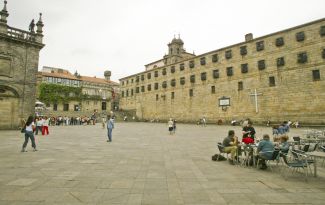
Marvellous
Plaza de la Quintana
This centrally located square marks the end of the journey for pilgrims going through the Holy Door to gain the Jubilee indulgence. Delimited by the Monastery of San Paio de Antealtares on the east, the square is divided into two areas divided by stairs that are impossible to go up two steps at a time. The top part is called Quintana dos Vivos and the bottom part Quintana dos Mortos, which points to the fact that it was formerly the site of a cemetery.
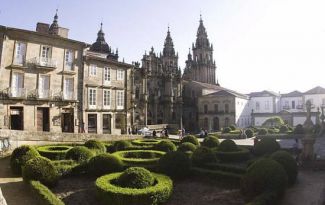
Feeling
Plaza de la Azabachería (Plaza de la Inmaculada)
The cathedral’s north façade (in neoclassical style) dominates the square called Plaza de la Inmaculada –commonly known as Plaza de la Azabachería due to the jet-stone workshops that were traditionally found in the area– which marks the end of the final stage through the city of the French, Original, Northern and English Ways. Numerous pilgrims go through the so-called Door of Paradise before finally stepping into the Plaza de Obradoiro. Just opposite, the Monastery of San Martín Pinario completes this matchless architectural ensemble.
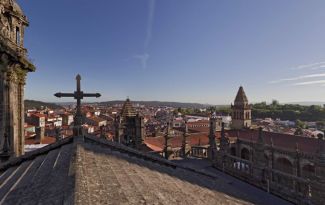
Overwhelming
Cathedral Rooftops
From the rooftops, 30 metres above the Plaza del Obradoiro, you’ll be able to contemplate the cathedral’s architecture from a different perspective, while enjoying impressive panoramic views of the city of Santiago de Compostela.
